In an article entitled "Film production", based on forty years of experience as a director, Alfred Hitchcock proposed a set of cinematic guidelines, describing the art of filmmaking in general as well as his own method in particular. The article is a successful attempt to pin down the key narrative elements of film art, ranging from the development of the screenplay to the use of music and colour. At the same time, it is Hitchcock's artistic credo. In the following pages, I will summarize some of the main points in Hitchcock's article, as a prelude to an analysis of Psycho. The screenplayFirst of all, Hitchcock believes in the importance of a thoroughly detailed screenplay, which should be prepared by the writer in collaboration with the director. The screenplay "sets out the dialogue, describes the movements and reactions of the actors, and at the same time gives the breakdown of the individual scenes, with some indication of the role, in each scene, of the camera and the sound" (Gottlieb, p. 211).The writer must be able to "anticipate, visually and in detail, the finished film". He must secure "a steady development of a plot and the creation of gripping situations arising out of the plot". Everything should be presented by visual means, avoiding the use of "interminable dialogue, which must inevitably send a cinema audience to sleep". Here Hitchcock proposes one of his many definitions of the mechanics of suspense, one of his most celebrated trademarks as a narrator:
"The most powerful means of gripping attention is suspense. It can be either the suspense inherent in a situation or the suspense that has the audience asking, "What wil happen next?". It is indeed vital that they should ask themselves this question" (Gottlieb, p. 212).The emotions of the audience are the crucial point in Hitchcock's narrative universe; these emotions are evoked by "gripping situations", which in turn stem from the basic structure of the motion picture, wherein dialogue plays a minor part. In general, Hitchcock does not rely on dialogue, but takes it on a short lead, writing the screenplay in collaboration with his screenwriters. In building up a character, a number of visual resources are available to the screenwriter:
[...] in particular the use of things. This is one of the ingredients of true cinema. To put things together visually; to tell the story visually; to embody the action in the juxtaposition of images that have their own specific language and emotional impact - that is cinema. [...] Things, then, are as important as actors to the writer. They can richly illustrate character (Gottlieb, p. 214). 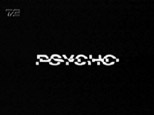 |
|
This narrative style was well-known at the time of the silent film, most particularly in the films of D.W. Griffith, but was unfortunately neglected in favour of dialogue with the advent of the sound film. From then on, relying on dialogue became the common practice. But according to Hitchcock, the skilled screenwriter knows how to make effective use of things and objects in the film, instead of falling "into the uncinematic habit of relying too much on dialogue".
Of course, the modern film cannot do entirely without dialogue. You cannot
shoot a motion picture exclusively in pictures. For that reason Hitchcock
agrees to a compromise: "Therefore the skilled writer will separate the two
elements. If it is to be a dialogue scene, then he will make it one. If it is
not, then he will make it visual, and he will always rely more on the visual
than on dialogue" (Gottlieb, pp. 214-215).
The cinema audience is the object of the director's efforts. Each shot is a statement made with the camera, for the purpose of creating a "state of mind, of emotion, in the audience. That is to say, the impact of the image is directly on emotions". Sometimes the director just wants to please the eye through the pictorial presentation, sometimes he wants to make a strong impact on the audience. In doing so, through his handling of all these narrative possibilities, the director reveals his style. And style is the crux of the matter. That is what it is all about:
"[...] perhaps the most significant and individually important thing about a director is his style. This style is evidenced by both his choice of subject and his manner of directing it. Important directors are known for their style" (Gottlieb, p. 216).And Hitchcock is certainly known for his highly personal style, as described by François Truffaut in the introduction to his famous conversation with Hitchcock: "Because he exercises such complete control over all the elements of his films and imprints his personal concepts at each step of the way, Hitchcock has a distinctive style of his own. He is undoubtedly one of the few filmmakers on the horizon today whose screen signature can be identified as soon as the picture begins" (Truffaut, p. 18). According to Hitchcock, some directors are more interested in refining their style and the treatment of the content than with seeking out new themes. They are mainly interested in the manner in which they tell their tales - a statement which applies perfectly to Hitchcock's own cinematic method. He is a storytelling director, interested in telling the story in his own manner.
He knows how to create an emotion in the audience, starting with the actor's
face, to which he will guide the eye of the spectator by his direction.
Everything begins with the actor's face, he says, referring to a maxim of
Ingmar Bergman's - the face on the screen in a certain pictorial frame. A
close-up or a long or medium shot, depending on the dramatic purpose. Whatever
the director's choice, Hitchcock emphasizes, "the content of the pictorial
frame must have an impact. [...] the rectangle of the screen must be charged
with emotion" (Gottlieb, p. 218).
Talking about the face, a good screen actor, in Hitchcock's opinion, is an actor who does nothing with his face, but in a convincing way. Then it is up to the director, through the cutting, to show the exact meaning of the actor's face. This is pure cinema. And in pure cinema, dialogue is a secondary thing. In this way, the films of Alfred Hitchcock differ from the majority of films, in which the story consists of illustrated dialogue, or photographs of people talking. In his further description of the director's use of cinematic means as part of the staging of the action, Hitchcock enumerates the following items: 1) sets and art direction; 2) lighting; 3) camera; 4) sound; 5) music; 6) colour; 7) wide screen; 8) editing; 9) the machinery of filmmaking. A detailed discussion of all of these items would carry us too far afield, and for that reason, I will confine myself to a few essential statements. The art director must not forget the camera when building a film set. This should be the aim of all construction, Hitchcock points out. An art director must be able to characterize a character in a movie "by what is on his walls", and Hitchcock concludes: "The main factor to be borne in mind in art direction, as in other areas of filmmaking, is the complete control that can be exercised not only over what the audience sees or does not see on the screen but even over the actual movements of the eye" (Gottlieb, p. 220). Camera movements are divided into two categories: 1) movements in relation to the movements of the characters, in which case the camera follows a character, and "the audience should never be aware of the camera"; and 2) dramatic movement of the camera, when the character is in repose: "[...] the camera may dolly up to the face of the character for emphasis, or dolly away at the end of a scene to reveal a lonely figure standing by himself in the center of a room. So used, the camera may be said to make a statement" (Gottlieb, p. 221). A metaphorical statement for a dramatic purpose, so to speak. Sound has many functions according to Hitchcock, such as dialogue in combination with images. Sound can also be used to illustrate a character's stream of consciousness together with the image of a thoughtful and unspeaking face - as an interior monologue. For Hitchcock, sound is generally very useful "in expressing the mental processes of the characters. [...]" (Gottlieb, p. 221). Music gives a certain atmosphere to a film, adds a dimension of mood: "The presence of music, then, is perfectly in accordance with the aim of the motion picture, namely to unfold an action or to tell a story, and thereby stir the emotions" (Gottlieb, p. 222). Once you have seen a Hitchcock film with the score written by Bernard Herrmann, you do not doubt the truth of this statement. Last but not least in this brief list of subjects covered by Hitchcock, is the use of editing, often described as the essence of making films. Hitchcock refers to both George Méliès, whose "strips of film were joined in a simple sequence", and Eisenstein and Pudovkin, who in the 1920s developed creative editing, so-called montage, a juxtaposition "of individual shots or frames, to illustrate character, to convey ideas". The passage about editing concludes with the following statement:
Whatever method is used, it is used with the realization that everything in cinema is a visual statement and the images are its language. Film, therefore, like any language, has its own syntax, which, as the word implies, is a lining up or ordering of images to create the maximum effect" (Gottlieb, p. 223).In this way, the essay "Film production" - published in 1965, five years after Psycho (1960), which was one of Hitchcock's most celebrated films - sums up Hitchcock's life-long experience as a filmmaker, illustrating the principles he applied when directing film and the cinematic style he practiced.
My reasons for choosing Psycho are: 1) because it is one of Hitchcock's
best films; 2) because it is one of the best examples of "pure cinema"; and 3)
because the story falls into two separate parts, which makes it possible for me
to concentrate on the first part in an analysis - the story of Marion Crane.
The aim of this analysis is to demonstrate where and how - in the first
sequences of Psycho - Hitchcock succeeds in giving each shot, each
frame, each bit of dialogue, another layer of meaning, in addition to the one
that is most apparent.
Psycho is a crime story, a horror suspense film, a psychological thriller. But it is also a film about family life - or the lack of one. But above all it is a very cinematic film, demonstrating Hitchcock's ability to film things and relations between people directly by using a metaphorical style. Or as Truffaut says: "[...] a film-maker isn't supposed to say things; his job is to show them" (Truffaut, p. 113). |
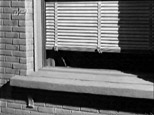
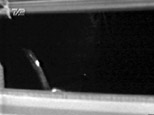 If we look closely at the sequence just described, we can see a significant pattern in Hitchcock's narrative style. The insistent panning and zooming shots and Bernard Herrmann's impressive music underline the movement from daylight to darkness, the transition from a normal city atmosphere to an abnormal world of claustrophobia, anxiety and shady love between two unfree people, the two lovers Marion Crane (Janet Leigh) and Sam Loomis (John Gavin) behind the Venetian blinds in their hotel room. A scene under Hitchcock's full control, carefully thought out and systematically carried through. The opening camera movement is not filmed in a standard or neutral manner. On the contrary it draws attention to itself, demanding not a literal but a figurative or metaphorical reading. The sequence is exclusively visual except for Herrmann's music, signifying the transition from normal to abnormal, referring to the story to be told. The camera works metaphorically as it progresses toward the window of the hotel room in which we will find Marion and Sam. And the music too works metaphorically, emphasizing the importance of the camera movement. Altogether the camera and the music enrich the depicted situation with numerous overtones. Thus the sequence opens as a kind of documentary film, but ends in a closed world of darkness: a mental prison. It opens by indicating time and place, but the rest of the film is an attack on place and time. Or as Robin Wood points out: "'Psycho' begins with the normal and draws us steadily deeper and deeper into the abnormal" (Wood, p. 112). "An opening or credit sequence can function metonymically for the whole of a film (the shots refer to the unravelling narrative to come)", Susan Hayward writes in her book "Key concepts in cinema studies", p. 217, thereby providing a precise definition of the opening sequence in Psycho. A similar view is stated by James Naremore:
"... in "Psycho", the first few images have more than expository value. They take us from surfaces to depths; from daylight to a sinister, murky darkness; from the most public view to the most intimate - thus announcing the movement of the film as a whole" (Naremore, p. 27).It is the manner in which the city, buildings and hotel window are filmed that transforms the situation from the commonplace to a world of sinister darkness behind the Venetian blinds. It is the whole visual and aural composition (the camera movement, the rhythm of the editing, the framing, the music), which guides the audience's eye and mind from an open and illuminated world to a dark and stuffy one, in which time and place slowly disintegrate. As a director. Hitchcock is only interested in his own vision of the world, which is why he always adds meaning or significance to the depicted events by using a metaphorical style. Hitchcock uses film language figuratively from the beginning of a film to its ending; he looks for the ultimate artistic alteration of a scene from its ordinary and general meaning to its abstract and metaphorical significance. Hitchcock wants to make a metaphorical statement in the opening shot, telling the audience what will happen in the next two hours. Making metaphorical statements is simply a logical consequence of the nature of the medium, according to Trevor Whittock's general conception of filmmaking: "[...] In the making of films, there are no "neutral" shots - they always carry a significance over and above that of being mere reproductions of that which was filmed" (Whittock, p. 28). |
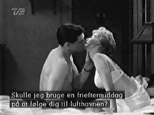 Sam: You never did eat your lunch, did you?What are they talking about? About lunch, work, sex, marriage, respectability and family (mothers, fathers). About the trivialities of everyday life and about the secrets of their lives without knowing it. The dialogue is at first sight very ordinary, but beneath the surface also very ambiguous, filled with overtones, and slightly ironic. Ordinary and everyday matters on the one hand, and existential issues on the other, depending on whether you read the "love scene" as a comedy or as a tragedy - or as a comedy which turns into a tragedy, corresponding with the transition from daylight to darkness in the opening shot. Both Marion and Sam are indebted to somebody and deprived of their liberty. For Sam it's a question of money. He must pay his ex-wife's alimony, and sweats to pay off his father's debts, which is why they cannot marry. For Marion it's a question of parent-child relations, expressed through her mother's picture on the mantel: a metaphor for her mother and father fixation, just as the family portrait in Suspicion (1941) is a metaphor for Joan Fontaine's parents' fixation. But while Suspicion is a comedy with a happy ending, Psycho is a tragedy ending the first part of the film with the famous shower murder of Marion, an event which is anticipated in Marion's lines: "[...] but when your time is up", "Sam - this is the last time" and "I pay, too". Because the dialogue wavers between comedy and tragedy, the audience can very easily overlook the metaphorical allusions in those lines. Especially the first time you see the film, because of the audience's concentration on Sam's and Marion's sexual activities in bed. According to James Naremore, the full meaning of such remarks "is not obvious when we first see the film, but on subsequent viewings, when we know what will happen at the Bates' Motel, it strikes us as grisly foreshadowing" (Naremore, p. 29). So the entire scene is fundamentally a portrayal of psychological problems, as already indicated in the title of the film. Psycho is a movie on the inner life of people who are dominated by the past. A movie about divided minds and split personalities, metaphorically expressed in the streaking gray horizontal and vertical lines, splitting apart the screen during the opening titles designed by Saul Bass. |
Caroline: Have you got some aspirin?At this moment the millionaire Mr. Cassidy and the owner Mr. Lowery enter the office:
Cassidy: Yeah, tomorrow's the day! My sweet little girl. Oh - oh, not - not you. My daughter. A baby! (sitting on Marion's desk) And tomorrow she stands her sweet self up there and gets married away from me. Ah - I want you to take a look at my baby. Eighteen years old - and she never had an unhappy day in any one of those years! 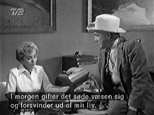
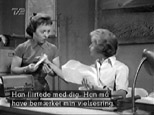
Literally, of course, the scene depicts a mere customer-salesman situation at a real-estate office, but that is not Hitchcock's business, or the reason why he has chosen to appear on the screen at this moment. The real reason is that he wants to make a visual statement, thereby becoming a metaphor in his own picture. Throughout the scene there is a very strong audience-identification with Marion, everything is seen from her point of view. But at the same time, Hitchcock's presence adds an extra point of view, giving us the key to the decoding of the scene. In the perspective of Mr. Hitchcock, standing outside the real-estate office with his cowboy hat, the scene is about something quite different than ordinary gossip and small talk between the characters in question. It is about the problematic relationship between parents and children. From that point of view the whole scene is a metaphor for Marion's mother or father fixation, including Caroline's talk of her domineering mother, Mr. Cassidy's possessive relation to his daughter, Mr. Hitchcock's "hidden" performance in the same scene as his own daughter Patricia Hitchcock (Caroline) and Mr. Lowery's paternal attitude. All these parent-child relations reflect Marion's identity problem as a woman under the influence. Robin Wood describes it in this way: "The whole fabric of the film is interwoven with these parent-child references [...]" (Wood, p. 113). But there is another interesting narrative element in the scene, Hitchcock's introduction of the "MacGuffin", a well-known dramatic device in many of his films. Mr. Cassidy's $40,000 are the "MacGuffin" which attracts the audience's attention, being the central plot element in the following scenes. According to Hitchcock's own definition of the "MacGuffin", it is "the term we use to cover all that sort of thing: to steal plans or documents, or discover a secret, it doesn't matter what it is. [...] The only thing that really matters is that in the picture the plans, documents, or secrets must seem to be of vital importance to the characters. To me, the narrator, they're of no importance whatever" (Truffaut, pp. 111-112). And here is another definition: "The 'MacGuffin' - my own term for the key element of any suspense story - has obviously got to change. It can no longer be the idea of preventing the foreign agent from stealing the papers. It can no longer be the business of breaking a code. And yet these very same elements, disguised to fit the times, must still be there" (Gottlieb, p. 124). And in Psycho the "MacGuffin" certainly has changed, compared to Hitchcock's former films, so that we should actually refer to the money as a semi-"MacGuffin". As such the $40,000 are of vital importance to Marion, but also of a certain importance to Hitchcock as the narrator, because he can use the money as a metaphorical element of narration. From now on, the money will circulate from scene to scene as a dramatic suspense element and at the same time establish the inner metaphorical connection between the scenes as a pars pro toto (part for the whole), reminding the audience of what transpired at the real-estate office. The $40,000 stand as part of the whole setting at the real-estate office, a scene to which they refer. In this way meaning is transported or transferred from scene to scene as part of Hitchcock's narrative economy. The money will be the central point of attraction in every scene, until Marion meets her fate at the Bates Motel. This ambiguous function is very obvious in the scene in Marion's bedroom, where the $40,000 in the white envelope, lying on the bed, are a challenge to Marion, to the camera which moves in for a close-up of the mesmerizing envelope on Marion's bed, and to the audience. |
The camera is very active and persistent, moving around in the room as a person or character, pointing out things of importance to look at (the money, the suitcase), while Marion walks around packing her suitcase. Here, she is dressed in a black bra and slip, a significant contrast to the love scene with Sam, where the bra and slip she was wearing were white. On the walls, we see pictures of Marion's parents and of Marion as a child, and on the bed the stuffed white envelope with the $40,000 she had promised her boss that she would put in the safe deposit box in the bank. The camera writes the scene - the camera as a pen.
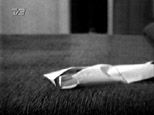
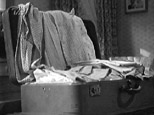 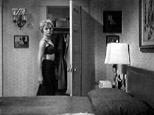
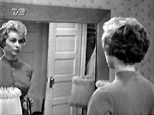
All of these narrative elements are charged with meaning because of Hitchcock's narrative style, which makes things signify something different from their ordinary meaning. In short, they are metaphors or rather metonyms for Marion's identity crisis. This is pure cinema. According to Hitchcock's artistic credo in his film essay, things are as important as actors, because they can richly illustrate character, as proven by this scene. The first time we see Marion's handbag and underwear, they are white. The next time we see them, they are black, marking a significant change from ordinary meaning to metaphorical meaning within the framework of the film. The first time we see a bed in Psycho, it is a bed for stolen love. The next time, it is a marriage bed because of the money. And the mirror image of Marion is not a "neutral" shot, but a metaphorical statement. But what is a metaphor, actually? "According to the linguist Roman Jakobson", Susan Hayward argues, "metonymy and metaphor are the two fundamental modes of communicating meaning" (Hayward, p. 216). A definition she develops further:
Metaphors [...] are very visible. They draw attention to themselves. Metonyms are not. And this is why the two terms can be seen as two sides of the same coin. Metaphors render the unknown visible, make the unknown have presence. Metonyms represent what is absent, stand as part of the whole story to which they refer, which is why they work invisibly. [...] Metonyms, then, are encoded, they organize meaning in a precise way. Metaphors have to be decoded. The juxtapositions of shots has to be read, understood by the spectator (Hayward, pp. 218-219).The "packing a suitcase" scene as a whole is a metaphor for departure, change and transition (a similar scene could be seen in Marnie (1964) with Tippi Hedren in the leading role). Marion steals the money because she wants to start a new life. The concept of "packing a suitcase" is in this way a metaphor for searching for a new identity. Using metaphors requires only that the director be very careful with his style:
Each cut of a picture, lasting from three to ten seconds, is information that is given to the viewer. This information is all too often obscure or downright incomprehensible, either because the director's intentions were vague to begin with or he lacked the competence to convey them clearly. To those who question whether clarity is all that important, I can only say that it is the most important quality in the making of a film (Truffaut, p. 15). |
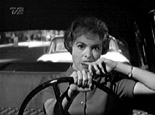
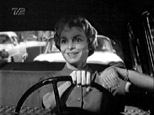 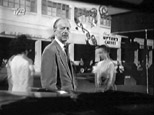
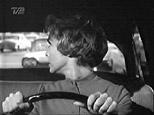
Marion suffers from bad conscience, and her sense of guilt is intensified, when her boss and Mr. Cassidy - Marion's two "office-fathers" - pass the cross-walk in front of Marion, as she waits at a stoplight before driving out of Phoenix. The scene is pure cinema in genuine Hitchcock style, with crosscutting between Marion's boss, smiling at her in the car, and Marion uneasily smiling back at him as he passes the cross-walk, followed by a new shot of the boss who is surprised to see Marion in the car, when she was supposed to be home in bed with a headache. Bernard Herrmann's pounding music helps to sustain the neurotic atmosphere of the sequence, when Marion continues driving. The main task of the director is to show what people are doing and thinking and, secondarily, what they are saying; and he must strive for the greatest economy in his film style, Hitchcock points out in his film essay. All of this applies perfectly to what happens in Marion's car, where Hitchcock combines the use of subjective shots, close-ups of Marion and voice over. With this economy in his narrative style, Hitchcock creates an enormous suspense and audience-participation in the scene - all because of the fatal money, which is not even visible.
Still the money determines the content of the scene, both dramatically and
metaphorically. In a way the money is "visible" in the scene, because it is in
Marion's mind - and also in the audience's mind as an inner picture. The
dramatic function of the money has to do with Marion's stealing the $40,000
without being arrested, while the metaphorical function has to do with
parent-child relations - in this case, with Marion's not obeying her boss. As a
little girl she is running away from her father, stealing his money (power,
control, influence) in search of a new life.
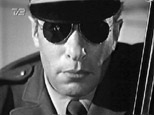
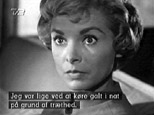 Patrolman: Hold it there! In quite a hurry.Marion is a little girl who wants to act like a big girl. But she is surrounded on all sides by more or less domineering father or mother figures: Sam - her fatherly lover, Mr. Lowery - her boss, her mother's picture on the mantel, Caroline's controlling mother, Mr. Cassidy and his daughter, Hitchcock and his daughter Patricia Hitchcock, and now the California highway patrolman. All fathers and mothers in Marion's universe. The highway patrolman is a menacing and ominous figure, who suddenly appears in the desertlike landscape. We see him mainly as a face. And what a face! Not the face of an ordinary policeman, but rather the face of an executioner. A face which has to be decoded, "has to be read, understood by the spectator" like a dream. The scene illustrates a dream, with different levels of meaning. The highway patrolman is of course a man doing his job, but he looks like a severe father or a judge, his face being a metaphor for all those attributes. As a person he is on another level than all the preceding fathers and mothers. Not a real or realistic father, but a metaphor for a judgmental and frightening authority. Love is absent in this scene as it is in most of the preceding and all the following scenes. Only Marion's sense of guilt, attached to her nervous and evasive behaviour, and the patrolman's increasing suspicion, pervade this fabulous scene, which James Naremore describes like this: "In the hands of most filmmakers, such an episode would be as flat as it sounds on paper, but Hitchcock makes it an indelible moment, an achievement of what one is tempted to call "pure cinema", if the term did not seem to indicate a merely formal beauty" (Naremore, p. 39). The scene demonstrates all of Hitchcock's skills as a film director: 1) his ability to film directly the feelings and thoughts of his characters without resorting to explanatory dialogue; 2) his suspense technique; 3) the editing; 4) the camera movement; 5) his use of point of view; 6) his use of the "MacGuffin"; 7) his use of metaphors. A cinematic style which Truffaut describes as follows:
"His style can be recognized in a scene involving conversation between two people, in his unique way of handling the looks they exchange, and of punctuating their dialogue with silent pauses, by the simplified gestures, and even by the dramatic quality of the frame. Just as unmistakably Hitchcockian is the art of conveying to the viewer that one of the two characters dominates, is in love with, or is jealous of, the other [...]" ("Hitchcock", p. 18). 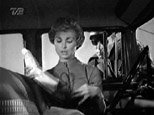
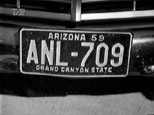
This is indeed pure cinema at its best, based on: 1) subjective camera; 2) audience identification; 3) suspense. To James Naremore
[...] it is a privileged moment in the film, a picture worthy of the surrealists, especially in the way it combines absolute clarity of presentation with the vague aura of a sexual nightmare. There are no gauzy, shadowy, expressionist techniques in what we see, and yet it is deeply evocative, with the power of staying in our minds quite apart from its function in the plot (Naremore, pp. 40-41).Concerning the metaphorical function of the money, there is an obvious chain of associations linking the money to Marion's Arizona car license plate number ANL - 709, to Marion's behaviour in front of her "father", the highway patrolman, his face being a voice of the past. She gives him the license, but hides the "money". To David Sterritt the meaning is clear: "If there is any doubt regarding Hitchcock's scatalogical turn of mind throughout Marion's ordeal, a closeup of her first car's license plate lays it to rest: It is ANL - 709, the letters spelling a revealing word while the numbers cushion an anuslike zero between two more substantial digits" (Sterritt, p. 106). In this way the money is a metaphor for defecation, signifying Marion's behaviour as anal-obsessive. A behaviour which is repeated in the next scene between Marion and the car salesman, yet another father figure in the film. |
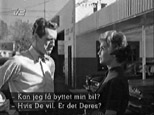 Marion notices the patrolman observing her from a distance. The salesman goes on talking about Marion's new car: Car Dealer: Go ahead and spin it around the block.Marion goes to the Ladies' Room, where she counts out the seven hundred dollars for her new car before returning to the salesman: Car Dealer: I think you'd better take it for a trial spin. Don't want any bad word of mouth about California Charlie.From a metaphorical point of view, the scene illustrates Marion's anal-obsessive behaviour. The car salesman behaves as an expert on cars and car selling, acting like a father ("I'm in no mood for trouble"). Marion does not want to discuss her choice of car, acting like a little obsessive girl ("No, thank you. I'm in a hurry: I just want to make a change" - "Can't we just settle this?" - "Is there anything so terribly wrong about - making a decision and wanting to hurry! Do you think I've stolen the car?").
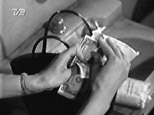
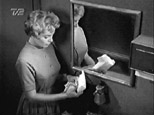
From a dramatic point of view, the scene between Marion and the car salesman is very much like the preceding one between Marion and the highway patrolman because of the patrolman's presence in the background of the picture, where he leans on his patrolcar and keeps a very suspicious eye on Marion's behaviour at the used car lot. Has he found out that she has stolen the money? What will he do? Because of our identification with Marion, we hope that she will get away from the patrolman, who is staring at her from a distance. The scene is pure suspense consisting of camera movements, editing, music, subjective shots, audience identification and metaphors, a melting together of expressive narrative elements, forming a synthesis. And last but not least Marion's impressive exit, when she drives off in her new car, starting - she believes - a new life. She is called back by a mechanic, because she has forgotten her suitcase and her coat in the old car. Being a metaphor for her wish to start a new life, the car change shows that Marion is still a woman under the influence, expressed through the transferred suitcase from the old car to the new one. Marion cannot change or get rid of her old identity.
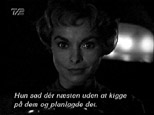

"[Hitchcock] is not merely an expert at some specific aspect of cinema, but an all-round specialist, who excels at every image, each shot, and every scene. He masterminds the construction of the screenplay as well as the photography, the cutting, and the sound-track, has creative ideas on everything and can handle anything, and is even, as we already know, expert at publicity!" (Truffaut, p. 18).  Talking about publicity, it is natural to mention the famous shower scene in Psycho. Perhaps the most celebrated scene in Hitchcock's entire film production. Everybody knows this scene, has heard about it, among other things because of Hitchcock's many newspaper interviews and well-known appearances on television, promoting his own films. I have not given a detailed description of this scene as the climax of Marion Crane's fatal journey into darkness, but will leave it to Hitchcock's use of metaphors in Psycho to evoke this dramatic occurrence in our minds. Thus the image of the shower in Marion's bathroom, as a metaphor for the shower murder, may complete the story of Marion Crane.
Anobile, Richard J. (ed.). Alfred Hitchcock's Psycho. London: Pan Books, 1974. |